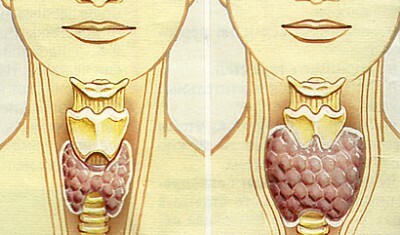How to determine the increase in the thyroid gland and what to do about it - a question that tortures many people. Despite the fact that such a pathology is common, most patients ignore it. As a result, untimely initiation of treatment and an increased risk of complications of the disease.

The thyroid gland may increase with various pathologies, so the definition of this symptom should not be considered by patients and doctors separately. In order to correctly diagnose an additional examination is necessary. Only a combination of the symptom complex and laboratory and instrumental examination data can provide all the necessary information in order to correctly diagnose and prescribe the necessary therapy.
Causes of
Most often this condition occurs because of a hereditary predisposition. This means that the doctor should clarify the presence of a similar problem with relatives. Another reason for the increase in the body is a violation of the process of iodine absorption by the body or its lack in food. With its deficiency, a disease occurs, which is called endemic goiter, but it is usually characteristic of certain regions.
Doctors call any goitre in which the thyroid gland is enlarged. If it is hypertrophied uniformly, it is called diffuse. It is also divided into toxic and non-toxic.
If there are nodules in the thyroid gland, it is a nodal goiter. Sometimes there is a mixed pathology, in which nodes develop and diffuse organ enlargement. The most common pathologies in this condition are hypothyroidism, thyroid cancer, thyrotoxicosis and adenoma.
Clinical manifestations
As is clear that increased thyroid gland, helps the clinical picture of the state, which can, depending on the functional state of the gland byteutireoidnym, hyperthyroid and hypothyroid, and depends on what symptoms.

Hyperthyroidism manifests hyperthyroidism of the thyroid gland. These include:
- Tachycardia;
- Metabolism acceleration;
- Pressure increase;
- Exophthalmos;
- Weight Loss;
- Diarrhea.
- Hypothyroidism is characterized by such symptoms:
- Pressure reduction;
- Hypotension;
- Bradycardia;
- Constipation;
- Inhibit;
- Puffiness;
- Weight Set.
Subclinical hypothyroidism often occurs with anemia and hearing loss. This is due to the edema of the Eustachian tube. It should be noted that with this pathology the hormonal function of the thyroid remains normal, which leads to the fact that patients complain of a visual increase in the organ. It can be so strong that the nearby vessels and organs are squeezed. As a result, difficulty breathing and swallowing, accompanied by severe dyspnoea and perephivaniem. Concomitant manifestations can be headaches and dizziness, increased intracranial pressure and pain in the eyes.
How to install the enlargement of the gland
To a person who is remote from medicine and who has not undergone the necessary examination, it is quite difficult to establish an organ enlargement. For self-diagnosis, you can use various tips and recommendations. But it should be borne in mind that this technique requires certain skills and experience, as well as application experience. After self-diagnosis, specialist consultation is always necessary, since it is impossible to prescribe adequate therapy without medical assistance.

Modern classification implies three stages of thyroid hypertrophy:
- Zero stage - no increase;
- There is a slight hypertrophy, but it is not determined visually and does not deform the neck;
- Hypertrophy is clearly visible, it deforms the front surface of the neck.
For self-diagnosis in the first place, you just need to look at yourself in the mirror. The first and third cases do not cause questions. If you notice an increase in the neck, then you need to immediately consult a specialist. If everything is as it should be - do not panic, everything is fine.
The most controversial point is the second stage, in which the thyroid gland is enlarged, but there is no deformation of the neck. This is a condition that is very difficult to detect visually. The best assistant will be the hands with which you can feel the gland. For this you need to know where it is located. The most typical place of its location is the cartilage of the larynx, located on the front surface of the neck. If you specify a little, this cartilage is called thyroid, outwardly it resembles a protective shield, from which the name of the organ is taken.
When swallowing this cartilage is displaced, therefore for the detection of the thyroid gland it is necessary to swallow saliva. It is necessary to place the thumb of one hand on the face on one side of this cartilage, and the remaining fingers on its opposite side. After performing this action, you can find a small formation, which is soft enough in consistency. This is the thyroid gland.

For maximum information about its condition, it is necessary to press a little on it, and also to perform several circular motions on the organ. This will establish the approximate size of the thyroid gland. It is not necessary to perform these actions too often, which are called palpation research of the thyroid gland, as it can be traumatized.
The second stage of the survey is the determination of soreness, size, assessment of density, mobility and the identification of nodes. For this you need to know the norm. Usually, one part of the body in diameter is approximately equal to the length of the distal phalanx of the thumb, while it is very important not to confuse the nail plate with the phalanx itself. The nail plate is just the nail itself along the length, the phalanx is the area of the finger, that is, it is larger in size. It ends at the point of the first fold of the finger.
Normal gland is soft, supple. If it is very dense, then a follow-up is necessary to exclude malignant processes. It should also be borne in mind that a healthy organ easily shifts when swallowed, as it moves along with the thyroid cartilage. The lack of normal mobility can talk about the presence of oncology.
It should be noted that palpation causes minor discomfort, and pain should not be in any case. Soreness indicates an inflammatory process, which is called thyroiditis, which can be acute or subacute. Also, painful sensations often occur with cancer, while they are associated with the fact that the tumor tissue grows into the capsule of the thyroid gland and adjacent organs.
The cause of pain in the thyroid gland is often related to the fact that the organ increases, stretches the capsule, because it contains a large number of nerve endings responsible for the sensation of pain. In the very tissue of the gland, there are no such receptors.

It is easy enough to probe the nodular formations of the thyroid gland. But, if they were not found during palpation, this does not mean that they did not form there. This is due to the fact that only large knots are well probed that have reached a size of more than 10 mm, as well as those that are closer to the surface of the neck, that is, superficial ones. Deep and small in diameter to determine very hard. For the purpose of their detection, the ultrasound examination of the organ is best suited, in the course of which it is possible to determine even the smallest formations.
It should be noted that such methods of research, as ultrasound or tomography of the thyroid gland, are prescribed exclusively by a doctor. But usually for the definition of nodular goiter, a normal ultrasound is sufficient, after which the patient is sent to donate blood to hormones to determine the functional state of the organ. You should not panic much if the nodes are soft, without severe pain and easily amenable to displacement. To suspect the presence of malignant processes can be when they are hard to touch, very painful when touched or even hot, and also do not shift.
If such a problem is found, it is necessary to contact the endocrinologist as soon as possible in order to undergo an adequate diagnosis of the thyroid gland and the purpose of treatment. Usually the examination includes palpation, ultrasound, scintigraphy to determine the function of iodine uptake by the thyroid, determination of its hormonal activity. Based on the data obtained, a diagnosis is made and treatment is prescribed.
Many people are tormented by the question of how it can be understood that the thyroid gland is enlarged, and then what to do with it. This is not such a complicated procedure, but it requires certain skills. It is best to consult a doctor who will perform the diagnosis of the organ, but if there is no such desire, then it can be done at home. Given the results of self-examination, you can decide whether to visit an endocrinologist.



